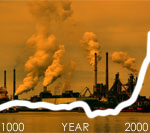Carbon market and credits concept
The carbon market helps tackle the issue of carbon dioxide emissions via the self regulating nature of market forces and conventional economics.
Imagine a system where a tonne of carbon has a certain value. The exact value will be determined by the laws of supply and demand using the following logic:
By forcing entities to be carbon neutral, a carbon market can be created with carbon emitters (the polluters) forced to offset / mitigate their output in one of the following ways:
- Pay a fine or tax to government or regulatory body who then invests the money into climate research and alternative / renewable approaches to industry.
- Purchase carbon credits from organisations / industries that have a positive carbon balance such as sequestration projects, tree planting etc.
- Fix internal processes and thus reduce or cut emissions completely (preferred outcome)
At first there will be a shortage of carbon credits on the market resulting in a high price with fines or taxes the more economic alternative. As carbon capture technologies develop and more people realise the potential to capitalise on environmentally positive activities, the availability of carbon credits will begin to increase, causing lower prices. As business is about making money, the current economic policy dictates that consumers (businesses and individuals) tend to favour the least expensive option.
With the trading of carbon using positive / negative balances it is possible to force businesses to measure and evaluate their environmental impact (at least in CO2 terms).
